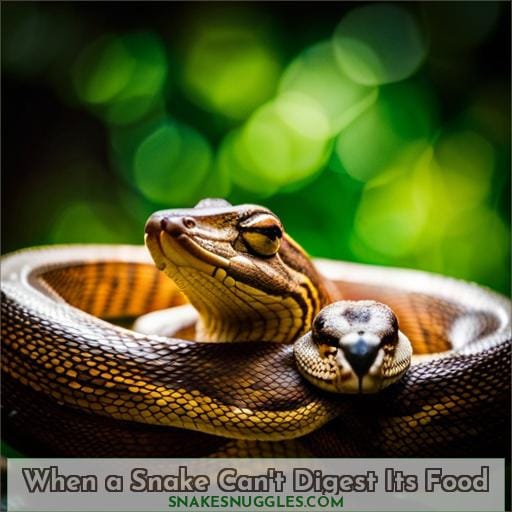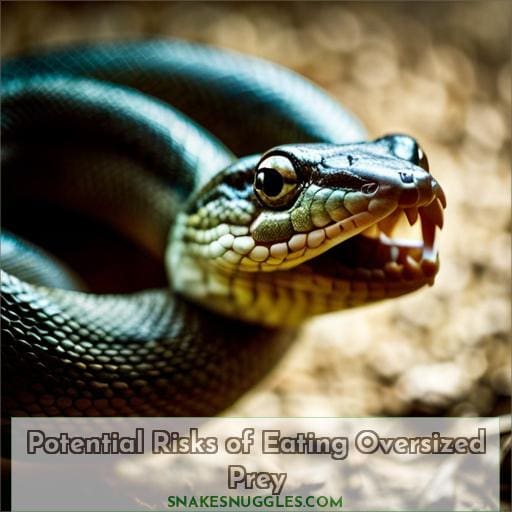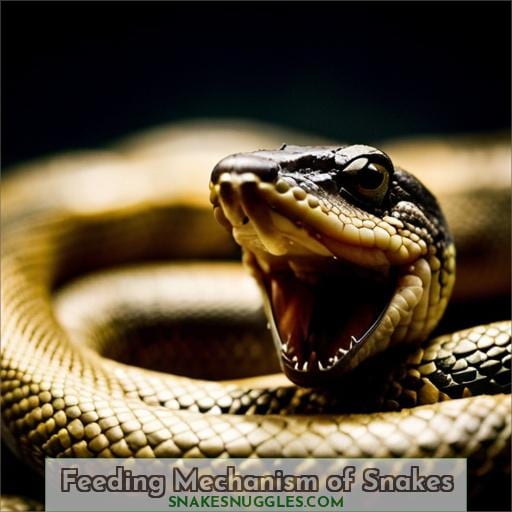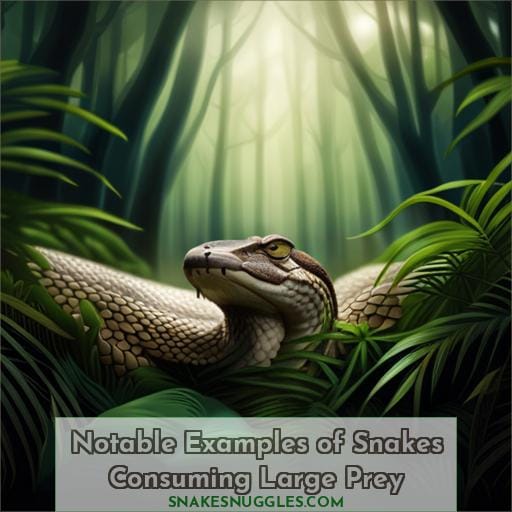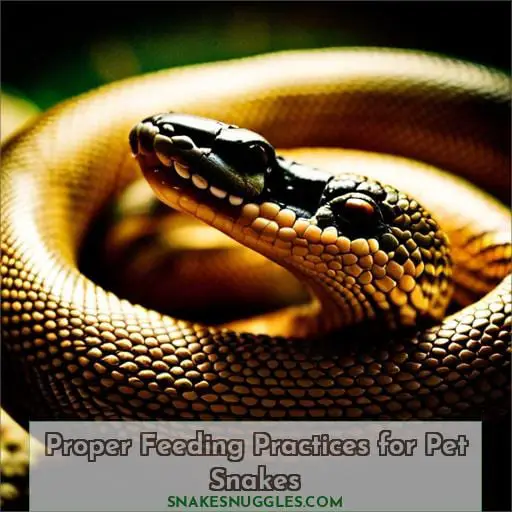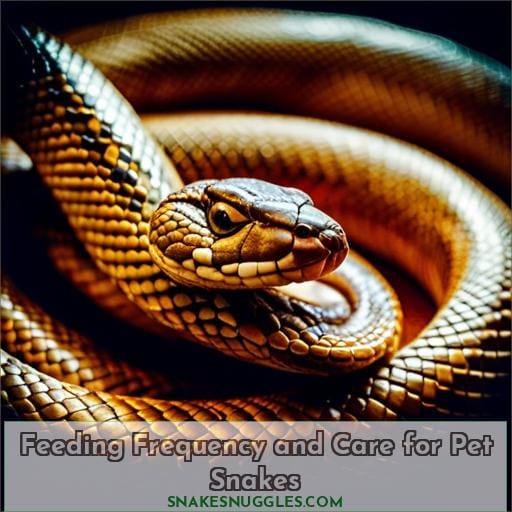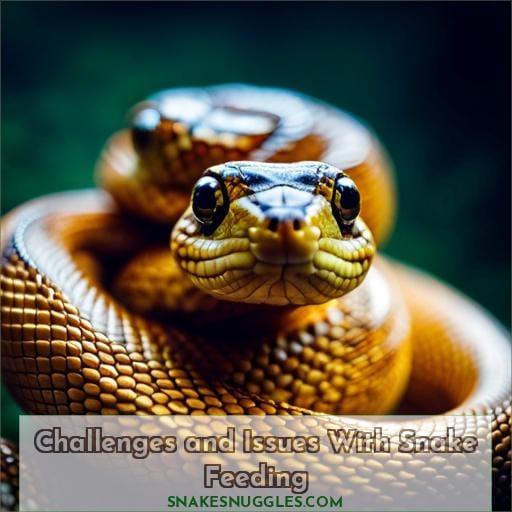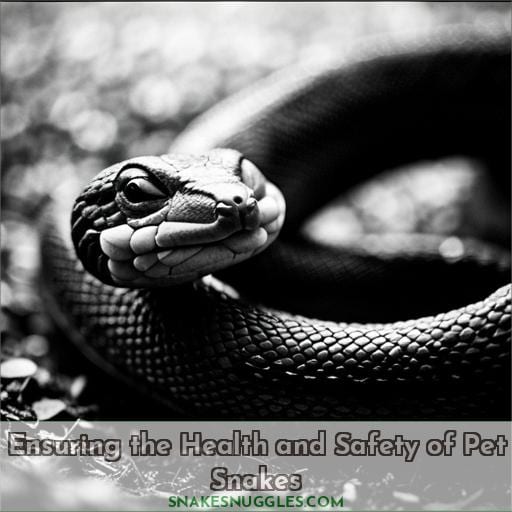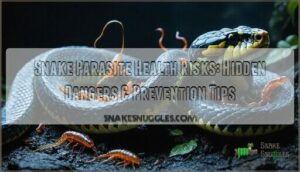This site is supported by our readers. We may earn a commission, at no cost to you, if you purchase through links.
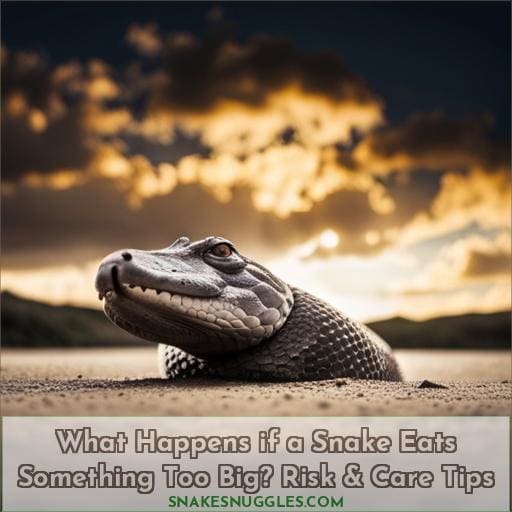 Treading on thin ice – that’s what a snake risks when it attempts to swallow something too big for its own good. But, do snakes really need to worry about choking? Can they consume prey larger than themselves and survive the process unscathed? In this article, we’ll delve into the risks of eating oversized prey, explain how snakes feed, and provide care tips for pet owners who want to ensure their beloved reptile remains healthy.
Treading on thin ice – that’s what a snake risks when it attempts to swallow something too big for its own good. But, do snakes really need to worry about choking? Can they consume prey larger than themselves and survive the process unscathed? In this article, we’ll delve into the risks of eating oversized prey, explain how snakes feed, and provide care tips for pet owners who want to ensure their beloved reptile remains healthy.
Table Of Contents
- Key Takeaways
- When a Snake Can’t Digest Its Food
- Potential Risks of Eating Oversized Prey
- Feeding Mechanism of Snakes
- Notable Examples of Snakes Consuming Large Prey
- Proper Feeding Practices for Pet Snakes
- Feeding Frequency and Care for Pet Snakes
- Challenges and Issues With Snake Feeding
- Ensuring the Health and Safety of Pet Snakes
- Frequently Asked Questions (FAQs)
- Conclusion
Key Takeaways
- Snakes risk choking when attempting to swallow prey that is too large for them.
- The size of the prey should not exceed the midsection of the snake’s body for safe digestion.
- Choking, regurgitation, and the risk of prey rotting are all associated with consuming oversized meals.
- Frozen prey is safer than live prey, so it is advisable to avoid feeding pet snakes live prey.
When a Snake Can’t Digest Its Food
Do you ever wonder if it’s possible for a snake to choke on its food? Snakes possess incredible abilities and have been known to consume animals much larger than their own size, but can they handle oversized prey? Reports of snakes eating deer, cattle, humans, and even a 150-pound hyena are documented, so what is the largest thing that a snake has eaten before?
Can a Snake Choke?
You may worry that your snake could choke if it takes on prey that is too large, but understanding their feeding habits and providing proper veterinary care can help keep them safe.
Snakes have flexible jaws, throat muscles, and body movements to swallow prey larger than their head or body size. However, regurgitation of oversized meals is common. Feeding frequency should be adjusted according to species and activity level for the best digestion results.
Knowing the largest meal your snake can handle helps prevent choking episodes, as well as potential damage caused by regurgitating large prey items. Veterinary care is necessary if stuck food obstructs breathing muscles in order to avoid injury or death of the reptile pet.
Can Snakes Eat Things Bigger Than Them?
Snakes can consume prey much larger than their own size due to flexible jaws and ligament-connected skulls, with some snakes capable of eating animals like deer or even a 150-pound hyena. Feeding frequency depends on species, size, and activity level; young snakes require more regular meals.
Pet snake owners should understand feeding habits and seek vet care if oversized prey won’t digest or presents other risks (i.
What is the Largest Thing a Snake Has Eaten?
Believe it or not, some snakes have taken their hunting skills to the extreme and eaten animals like deer, cattle, and even a 150-pound hyena! From pet care to vet attention, understanding snake eating habits is vital.
Prey size should be appropriate for snake diet; too big can cause swallowing difficulties. Feeding frequency depends on species and activity level; live prey is risky but frozen works well.
Potential Risks of Eating Oversized Prey
If you own a pet snake, it’s important to be aware of the potential risks involved in feeding them oversized prey. When a snake ingests something too large for their digestive system, they may regurgitate or vomit the food out – both scenarios can lead to serious injuries and even death due to tissue damage or rotting prey within the body.
Knowing how much is too much for your pet will help ensure its safety and well-being.
Regurgitation and Its Consequences
When a snake consumes prey that is too large for it to digest, regurgitation can occur and cause serious damage or even death.
- Monitor prey size relative to the midsection of the snake’s body.
- Employ throat muscles and body movements when swallowing.
- Follow appropriate feeding practices for pet snakes.
- Seek out veterinary care if issues arise with digestion or regurgitation harms the snake due to oversized prey damage.
Damage to the Digestive System and Tissues
Eating prey that is too large can cause damage to a snake’s digestive system and tissues. For example, an African Rock Python was found with severe injuries after attempting to swallow a waterbuck calf.
Jaw flexibility allows snakes to consume oversized food, but throat muscles and body movements are necessary for digestion – failure of which can lead to regurgitation risks requiring vet care. Prey size must be monitored as improper swallowing leads the snake into dangerous territory when it comes to its health.
Rotting Prey and Complications
Consuming too large of a meal can lead to rotting prey inside the snake before regurgitation, resulting in further complications.
- Digestive issues due to oversized prey size
- Choking risks if the food obstructs breathing muscles
- Veterinary care needed for stuck or rotting prey
- Growth stunting from irregular feeding frequency. If these occur, contact an expert immediately as ignoring it may cause serious injury or death. Regular monitoring and following the recommended feeding size is essential for keeping snakes healthy and safe.
Feeding Mechanism of Snakes
Snakes have evolved to be able to eat prey larger than their own size due, in part, to their flexible jaws and ligament-connected skull. Swallowing large meals requires throat muscles working in tandem with body movements such as rib contraction and backbone extension for the successful ingestion of oversized prey.
Jaw Flexibility and Swallowing Techniques
Your snake’s jaw flexibility and swallowing techniques allow it to devour prey larger than itself, though caution is advised. Jaw strength combined with throat muscles helps the reptile adjust its body to rotate the oversized prey into a suitable position for swallowing.
Movements of its rib cage and backbone also provide assistance in pushing food down towards digestion. Snakes must be mindful of their respiratory system when eating large meals; if any signs of obstruction occur, adjustments need to be made immediately or they could choke on their meal.
Finally, feeding reflexes help snakes swallow more quickly while avoiding potential risks associated with consuming too much at once.
Muscle Movements for Ingestion
You can observe snakes using throat muscles, rib movements, and backbone contractions to help push down large prey along their body for successful digestion. These muscle anatomy techniques allow the snake to adjust its feeding position, open up its glottis, and swallow food sources larger than itself.
Properly sized prey ensures a safe digestion process without risking injury or harm to the snake’s digestive system.
Here are some key points about what happens if a snake eats something too big:
- Too big prey can damage the digestive system of a snake, potentially causing harm.
- Regurgitation might occur due to an oversized food source.
- Choking is also an issue when an animal consumes something too large for its size.
Inadequate nutrition from consuming overly large items increases health risks; thus, it’s important that owners monitor their pet’s eating habits accordingly.
Notable Examples of Snakes Consuming Large Prey
You might be surprised to learn that snakes possess the unique ability to consume prey much larger than their own size, such as deer, cattle, and even a 150-pound hyena. While instances of them consuming humans are extremely rare, understanding what happens if a snake eats something too big is important for pet owners.
Animals Consumed by Snakes
Amazingly, snakes have been known to consume animals such as deer and cattle, with one instance involving a 150-pound hyena. They also prey on smaller creatures like mice and rats. Jaw flexibility allows these reptiles to open their mouths wide enough for sizable meals, while throat muscles help propel the food down their bodies using rib movement and backbone contractions.
Rare Instances of Snakes Consuming Humans
Incredibly, there have been rare instances of snakes consuming humans. It’s believed that the dynamics between humans and snakes play a role in these cases. Certain snake species are known to be more curious and less afraid of humans than other animals.
Additionally, dietary habits and prey selection can influence this behavior, as well as environmental factors such as food availability or lack thereof. Ingesting a human could lead to serious issues with digestion. However, it is unclear if this is because the prey was too large for the snake or due to physiological differences between animal and human tissue.
Nonetheless, understanding their natural behavior remains key when observing any type of predator-prey relationship involving snakes.
Proper Feeding Practices for Pet Snakes
As a pet snake owner, it’s important to understand the proper feeding practices for your reptilian companion. Appropriate prey size should not exceed the midsection of its body to aid in digestion. These can include small rodents like mice or rats, cut-up chicken, or small birds.
Dead or frozen prey is preferable over live prey as there is less risk of injury for your pet snake.
Appropriate Prey for Pet Snakes
Pet snakes should be fed small rodents, cut-up chicken, or small birds that are no larger than their midsection. Live prey can cause injury and is not recommended – frozen prey is a safer option. To ensure proper digestion, feeding frequency depends on snake size, species, and activity level; younger snakes may need more frequent meals.
Veterinary care might be necessary if the snake ingests oversized food or gets stuck with live prey for too long – it’s important to differentiate between regurgitation and vomiting as this could indicate illness in the pet.
Prey Size and Digestion
Consuming prey that is too large for your snake can be a risky endeavor. To ensure they digest properly, pet snakes should not eat prey larger than their midsection: 1) Jaw flexibility allows them to do so; 2) Regurgitation and rotting prey are common issues; 3) Choking is also a risk if the food obstructs airways.
4) Understanding feeding habits and frequency helps prevent problems. 5) Veterinary attention may be necessary in rare cases.
Live Prey Vs. Dead or Frozen Prey
When it comes to feeding pet snakes, there is a distinct difference between offering live prey and dead or frozen prey. Live prey poses greater risks of regurgitation due to the snake’s reflexive strike, while frozen food reduces handling risks.
Avoiding regurgitation means safer digestion, so always opt for frozen meals when possible. This will help ensure that your snake does not suffer any ill-effects from trying to consume something too big for their body size and can keep them healthy in the long run.
Feeding Frequency and Care for Pet Snakes
As a pet snake owner, it is important to understand the factors that affect feeding frequency, such as snake size, species, and activity level. Knowing your pet’s individual habits and needs is critical when it comes to providing appropriate nutrition.
Any stuck prey or vomiting should be evaluated by a veterinarian for proper care.
Factors Affecting Feeding Frequency
Depending on the size, species, and activity level of your snake, you’ll need to adjust their feeding frequency accordingly. Muscles movements and jaw flexibility can help ingest larger prey than usual, but too much is dangerous.
Vet care should be sought if prey gets stuck or regurgitation occurs due to the wrong type/size of food.
Understanding Feeding Habits
Knowing your snake’s feeding habits is key to keeping it healthy; young and small species need meals up to twice as often. A pet owner should understand the animal’s digestive system, jaw flexibility, and frozen prey options.
Veterinary care is essential for recognizing regurgitation or vomiting issues that can arise from oversized prey consumption.
Veterinary Care for Stuck Prey or Vomiting
If your snake is struggling to swallow large prey or vomiting, it’s important to seek veterinary care right away. The size of the prey should not exceed the midsection of their body, and live prey should be avoided as much as possible.
Frozen food is a safer option. Knowing feeding habits for different snake species and sizes is key in keeping them healthy. An expert can advise you on how to properly feed your pet snake and prevent any potential issues arising due to oversized meals or sicknesses related to eating too much at once.
Taking these precautions will ensure that your pet stays safe from harm caused by incorrect feeding practices.
Challenges and Issues With Snake Feeding
Feeding a snake can be challenging, as they must adjust to oversized prey that often gets stuck in their throats and poses choking risks. Swallowing such large food items requires specialized abilities due to the flexibility of their jaws and ligament-connected skull structure.
Difficulties in Swallowing Prey
Consuming prey that is too large can put a serious strain on your snake’s health and well-being. To avoid this, pay attention to feeding habits and the size of the prey compared to the snake. When digesting oversized meals, snakes rely on throat muscles and body movements, combined with digestive enzymes, for successful digestion.
However, regurgitation risks still exist due to choking or rotting food inside the stomach.
Adjusting to Prey That Gets Stuck
When attempting to consume prey that is too large, snakes may find themselves with stuck prey in their mouth for an extended period of time, requiring veterinary attention. This can lead to injury or risk the digestive system being compromised due to the size of the food and prolonged contact with it.
If a snake owner notices this issue, they should consult experts as soon as possible and be aware that feeding frequency should be adjusted according to species, size, and activity level.
It’s essential for pet owners to not only understand proper feeding practices but also know how potential issues are addressed.
Choking Concerns
Choking from oversized prey can be a looming fear for your pet snake. To protect its health, consider regurgitation risks, jaw flexibility, throat muscles, and seek veterinary care if animal consumption becomes an issue.
- Regurgitation risks
- Jaw flexibility
- Throat muscles
- Veterinary care
Ensuring the Health and Safety of Pet Snakes
As a pet snake owner, it is important to understand the risks associated with feeding your pet. Taking into account size recommendations and recognizing possible choking hazards is key for keeping your reptile safe and healthy.
If you are ever unsure of how to safely feed your pet snake, be sure to seek assistance from an expert in the field.
Feeding Size Recommendations
It’s important to ensure the size of prey doesn’t exceed the midsection of your pet snake’s body, as a meal that is too large can cause serious complications. Regular meals and careful selection of appropriate prey types will help maintain digestive health.
If problems arise, seek veterinary care immediately for proper diagnosis and treatment.
| Emotion | Description |
|---|---|
| Fearful/Anxious | Ensuring safety from harm |
| Contentment/Relief | Knowing what to do if something goes wrong |
Feeding pet snakes requires knowledge regarding regular meals, size selection, and prey type in order to keep them healthy and safe. It is essential for owners to understand the risks posed by oversized food items; however, with vigilance, they can be minimized or avoided altogether with regular vet check-ups when necessary.
Understanding Choking Risks
Consuming oversized prey can put your pet snake in serious danger, as an obstructed airway can quickly turn the feast into a fatal mistake.
- Regurgitation risks increase with large prey.
- Feeding mechanism requires throat muscles and body movements.
- Pet care includes proper frequency of meals.
- Veterinary assistance is needed if stuck prey occurs. Keeping these elements in mind will help maintain your pet’s health and reduce choking risks associated with overfeeding.
Seeking Assistance for Feeding Issues
If your pet snake is having trouble with feeding, it’s important to seek help from experts. Veterinary care can ensure the right size food and type of prey for a snake’s needs. Knowing a species’ dietary requirements and habits is essential in providing proper nutrition without risking health issues or regurgitation due to oversized prey.
Frequently Asked Questions (FAQs)
How can I tell if a prey item is too big for my snake?
To determine if a prey item is too large for your snake, watch for signs of strain. If the meal stretches your pet’s jaw and body beyond their limits, it may be time to reduce the size. Remember the saying, ‘too much of a good thing can be bad’. Keep a close eye on your snake and seek professional assistance when necessary.
What are some signs that my snake is having difficulty digesting its food?
Signs that your snake is having difficulty digesting its food include regurgitation, vomiting, and choking. Occasional excessive salivation or loss of appetite can also be potential signs of trouble. Seek help from a vet if you notice any worrying symptoms to ensure your pet stays healthy.
What can I do to prevent my snake from regurgitating its food?
To prevent your snake from regurgitating its food, feed it appropriately sized prey that won’t exceed the midsection of its body. Use dead or frozen prey instead of live to reduce the risk of injury. Monitor feeding frequency based on size and species; young snakes may require more frequent meals.
If stuck in the mouth for an extended period, seek veterinary attention immediately.
Is it safe to feed my snake live prey?
It is risky to feed your snake live prey; it’s better to use dead or frozen prey to prevent injury. Choose an appropriate size that does not exceed the midsection of the snake’s body and consult experts if you observe any vomiting.
What should I do if I think my snake has ingested something too big?
If you think your snake may have eaten something too big, contact a veterinarian immediately and stop feeding it. Monitor the snake for signs of regurgitation or illness. If necessary, seek help from an expert to ensure its health and safety.
Conclusion
It’s clear that eating oversized prey can be dangerous for snakes. Regurgitation can cause serious injury and even death if the prey is too large for the snake to handle. Snakes employ throat muscles and body movements to swallow prey, allowing them to ingest animals much larger than their own size.
However, it’s important for pet snake owners to understand the risks and follow feeding guidelines. Prey size should not exceed the midsection of the snake’s body, and frozen or dead prey is recommended to reduce the possibility of injury.
If a snake is vomiting or choking on prey, immediate veterinary care is necessary.
By taking the proper precautions, pet owners can ensure their snake’s safety and health when it comes to eating something too big.

